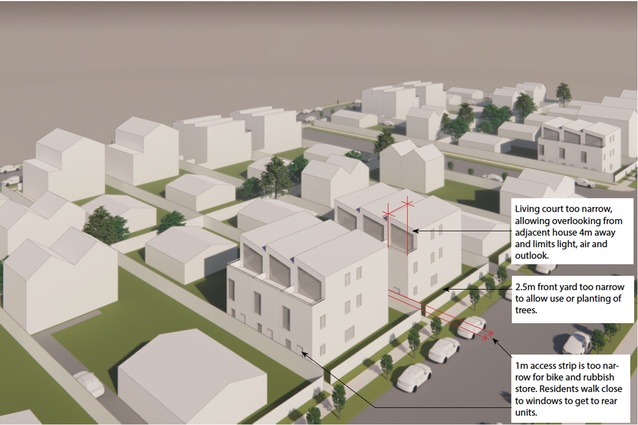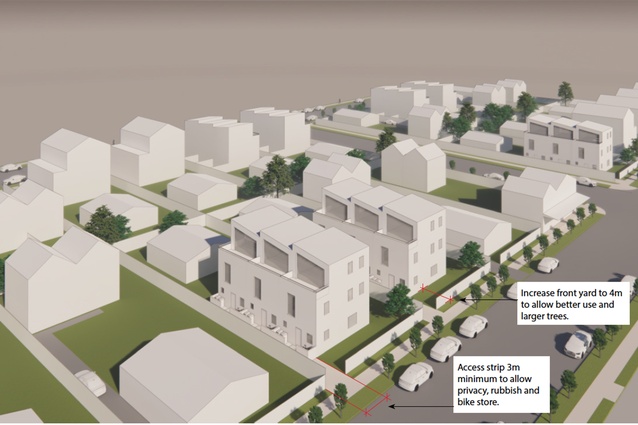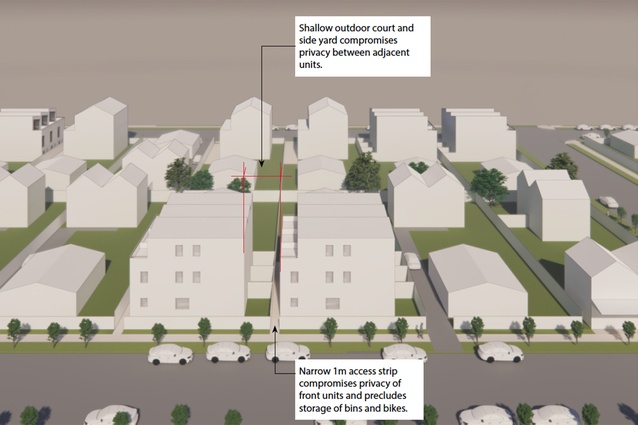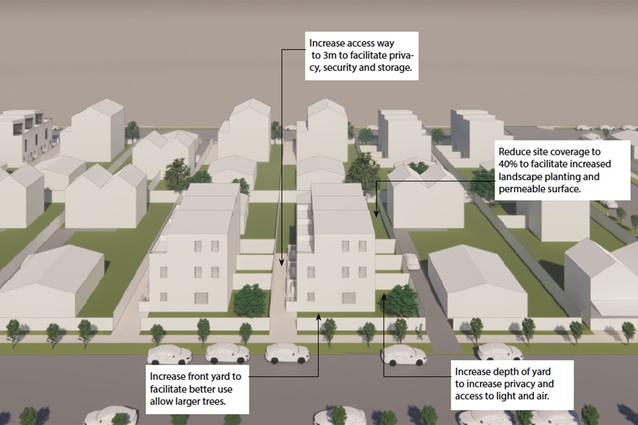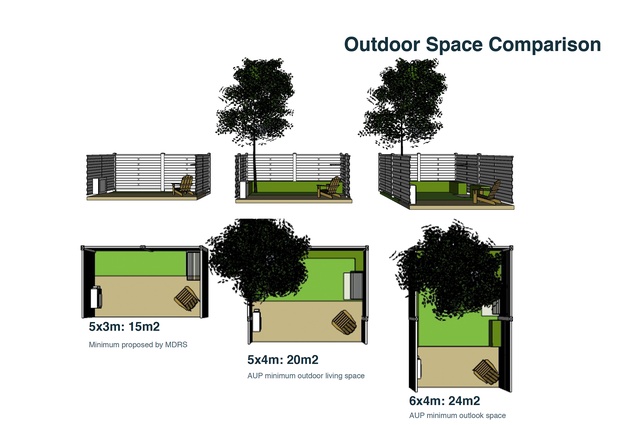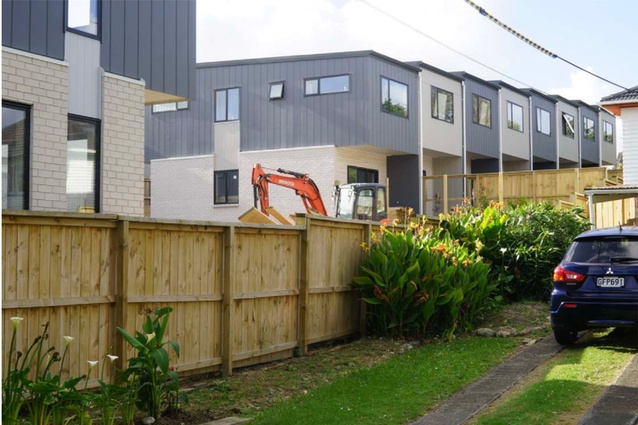The Diary of a Debacle: The Slum Enabling Act and Other Matters
Te Kāhui Whaihanga New Zealand Institute of Architects Distinguished Fellow and past Chair Urban Auckland, Julie Stout, says the Resource Management (Enabling Housing Supply and Other Matters) Amendment Bill’s proposal to change the development standards for all housing zones, from Single House to Mixed Housing Urban, into one set of minimums that ignores the enormous differences inherent in these zones will create a blanket approach to city planning.
Round 1
Here we are, in a state of lockdown, worrying ourselves sick about Covid-19 spreading and what are we going to do about the very real impact of climate change, when, virtually out of the blue, the Government detonates an H-bomb right underneath every residential area in the country, the enormous effects of which are now rumbling towards us.
The problem is very real alright; housing supply and affordability. But this solution appears to be born out of an economic report provided by PricewaterhouseCoopers and Sense Partners Data Logic Action, outlining the Cost-Benefit Analysis of getting rid of residential planning rules in Aotearoa’s cities. The Bill was hatched in secrecy within Government.
City Councils throughout the land were still busy dealing with the impact of 2020’s National Policy Statement on Housing and Urban Development (NPS-UD), instructing Councils of a long-term vision and change to areas of Mixed Housing Urban and Terrace Housing and Apartment zone, including a requirement to increase density to 6 storeys in town centres and along transport nodes, with the aim of providing more housing, affordable homes and to foster communities that could flourish in liveable future-resilient neighbourhoods with green spaces and employment opportunities nearby. Plus support Māori-driven housing and urban initiatives and address homelessness.
While that National Policy Statement was a big ask for local Councils to ‘tool up’, many people understood the urgent need to address housing supply, affordability and intensification in the appropriate places supported by schools, parks, public transport and pipes. Many people up and down the land are devoting their lives to ensure the solutions produce a long-term positive; development planned for a reduction on car reliance, higher-density neighbourhoods with a range of housing types, including affordable, that protected and enhanced environmental outcomes, cherished heritage. Development that created good, if not great, places for a range of people to form communities. Good stuff – homes for all – the basis of a stable society. Planned quality growth rather than leaving it to market forces.
Much of this work was building on the Auckland Unitary Plan process that many of us here in Tāmaki Makaurau were involved in. Members of the NZIA and other professional planning groups divided up the planning map of the whole city into A4 sheets of paper and collectively analysed areas for constraints and opportunities as to their future housing zone. It was a process built on collaboration and knowledge of local areas, it involved community discussions. It also involved attending angry community meetings to assure locals that, no, our city wasn’t going to end up like Eastern Germany because we would ensure quality design standards. The end result, the Unitary Plan was, while not perfect, a very clear roadmap to making Auckland the distinctive and liveable city it is becoming. Auckland Council has been processing a record number of home building consents, with a 56% increase in multi-unit homes… and there is ample provision in the Unitary Plan capacity for growth for the foreseeable future. So, increasing supply is possible under existing rules and enabling higher densification takes time, but we were getting there.
With this Bill, introduced on November 4, all that is now under real threat of being swept away.
To try and get quick housing supply up and running, the Resource Management (Enabling Housing Supply and Other Matters) Amendment Bill proposes to abolish all Housing Zones from Single House to Mixed Housing Urban into one residential zone, ignoring the enormous differences inherent in these, to create a blanket approach to city planning. The so-called standards that will form new developments:
• do away with a minimum lot size
• increase building coverage to 50
• increase height in relation to boundary controls to 6m and 60 deg for ALL boundaries with neighbours (regardless of orientation)
• increase height to 11m–12m
• setbacks are 2.5m front yard and 1m to side yard
• outdoor living 15sq m, or 8sq m balcony
• allow a principle outlook space 3m x 3m and 1m x 1m all other habitable rooms
• there is NO minimum landscape requirement
• there is NO protection for existing trees
• there is NO protection for ‘character areas’ to be maintained
• and NO Resource consent needed for up to three units in any zone or notification nor right-of-appeal on implementation of the NPS UD. Streamlined it’s called.
Right question, totally wrong answer. The over-arching idea here is to “flood the market” with multi-unit housing put up by “mom and dad investors” – yeah right.
Some proponents think we have to “get down and dirty for a while”, as if the Housing Crisis was a mud wrestling match and, once over, we can all have a shower to wash it away. Housing doesn’t work like that. Housing is part of a neighbourhood, is part of a city, and it is where people live. It is where we all live. What happens now, happens for a long time.
That is what I can’t understand. Our homes and where we live are of enormous importance to most, if not all, of us, whether we own our own home or we are renting. We all want to know it is not going to be trashed by an opportunistic neighbour/developer who can build 3-storeys-high right on our boundary or cut down that 100-year-old (unprotected) tree. Goodbye to any notions of an urban forest for Tāmaki Makaurau.
Allegations of “Nimby-ism” get quickly thrown but architects are trained to look after the built environment like a doctor looks after people. We want the best environment for all so that all of society and the environment benefits. What really gets me is that, after nearly two years of putting our faith in the government’s measured response to the Covid pandemic and our daily listening to the advice of the medical experts and science, when it comes to solving the Housing Crisis, no one in the built environment profession, nor anyone in the territorial Councils who have invested so much in their communities, is consulted. No one. Just some economists.
What next? Judith Collins quickly recognised the laissez-faire approach here as something she could make hay with and joined ranks with Labour making this Bill virtually unstoppable in Parliament. The so-called democratic process is breathtakingly fast: three weeks from notification to get a submission in last Tuesday on the most far-reaching planning legislation in our history, appearances via Zoom before the Parliamentary Select Committee a day or two later, who, in turn, have three weeks to make a Report to Government, who wish to pass the Bill on 16 December so it is signed off by Royal Decree by Christmas.
You would think it was a war… well, it’s just starting.
Julie Stout
Distinguished Fellow Te Kāhui Whaihanga New Zealand Institute of Architects
Professional Teaching Fellow, UoA School of Architecture and Planning
Past-chair Urban Auckland
Mitchell Stout Dodd Architects
The Urban Auckland submission can be viewed here.
Further submissions to the Parliamentary Select Committee can be read here and on the Te Kāhui Whaihanga New Zealand Institute of Architects website.

